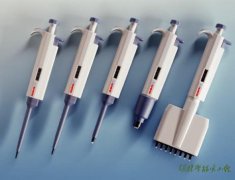Column Chromatography
发布日期:2016-06-10 07:59
来源:网络
作者:网络
浏览次数:
Column chromatography is frequently used by organic chemists to purify liquids (and solids.) An impure sample is loaded onto a column of adsorbant, such as silica gel or alumina. An organic solvent or a mixture of solvents (the eluent) flows down through the column. Components of the sample separate from each other by partitioning between the stationary packing material (silica or alumina) and the mobile eluent. Molecules with different polarity partition to different extents, and therefore move through the column at different rates. The eluent is collected in fractions. Fractions are typically analyzed by thin-layer chromatography to see if separation of the components was successful.
|
Packing a (silica gel) column: |
|
-
Use a piece of wire to add a plug of cotton to the bottom of the column. There should be enough cotton that the sand and silica will not fall out of the column. However, too much cotton or cotton packed too tightly will prevent the eluent from dripping at an acceptable rate.
-
Clamp the column to a ring stand and add enough sand to fill the curved portion of the column.
-
Place a pinch clamp on the tubing, then fill the column 1/4 to 1/3 full with the intial eluent. (The composition of eluent is often changed as the separation proceeds.)
-
Prepare a slurry of silica in the intial eluent by pouring dry silica into a beaker of eluent. (Add a volumne of silica gel, such as 20 mL, to approximately double the volume of eluent, 40 mL.) CAUTION: keep the dry silica in your hood and be careful not to inhale the lightweight substance.
|
Step 1

|
-
Quickly but carefully pour the slurry into the column. Stir and pour immediately to maximize the amount of silica that goes into the column instead of remaining behind in the beaker. You may find a clean spatula or glass rod helpful in transfering the silica.
-
Remove the pinch clamp to allow solvent to drip into a clean flask. Tap on the side of the column with a rubber stopper or tubing to help the silica settle uniformly.
-
Use a Pasteur pipet to rinse any silica that is sticking to the sides of the column. Allow the silica to settle while eluent continues to drip into the flask.
-
Once the silica has settled, carefully add sand to the top of the column. Sand is heavier than silica. If the silica has not settled, the sand may sink into the silica instead of forming a layer on top of it. (You may need to rinse down sand that sticks to the side of the column.
|
|
|
|
|
|
Column after Step 3
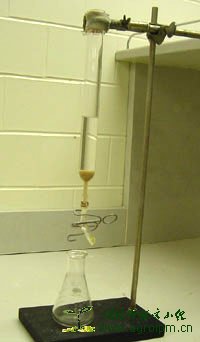
|
Step 5
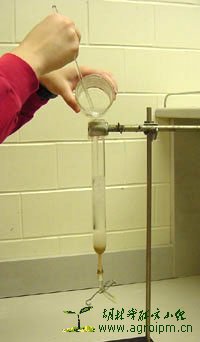 |
Column after Step 9

|
|
|
|
Loading a sample onto the column: |
|
-
Drain eluent from the column until no solvent remains above the surface of the sand.
-
Using a long Pasteur pipet, carefully add your sample to the column.
-
Drain eluent from the column until no sample remains above the surface of the sand.
-
Use ~ 1 mL of eluent to rinse your container and pipet. Add this milliliter of sample to the sand. Drain eluent from the column until no liquid remains above the surface of the sand.
-
Repeat step 12 two or three times to completely transfer your sample onto the silica gel. If you do not do and repeat step 12, your sample will remain in the sand instead of on the silica. Sample remaining in the sand will dissolve in the eluent that you add in step 14, ruining the possibility of good separation of components.
|
Step 10
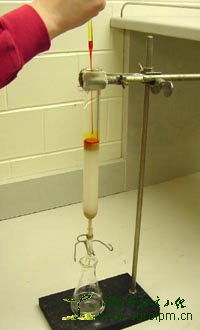
|
|
Eluting the sample: |
-
Once you have rinsed your sample onto the silica, carefully add eluent to the top of the column. To avoid disturbing the top of the column, it's a good idea to carefully pipet an inch or two of solvent onto the column instead of pouring solvent directly onto the sand.
-
Add more eluent as necessary. The eluent collected prior to the elution of sample can be recycled. The composition of the eluent can be changed as the column progresses. If the eluent composition is to be changed, ALWAYS start with least polar solvent/mixture and change to the more polar solvent/mixture.
|
Column after Step 13
 |
Components a, b, and c separate as column progresses.
 |
Fractions can be collected in test tubes, vials, beakers, or Erlenmeyer flasks.
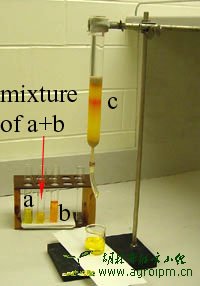 |
|
|
Analyzing the fractions: |
|
|
-
Analyze the fractions by thin-layer chromatography to determine a) if the fraction contains more than one component and b) if fractions can be combined without affecting the purity of those fractions.
|
|
intial TLC
|
TLC of fractions
|
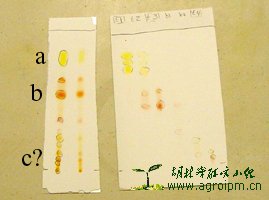 |
|
|
Other Comments: |
-
The success of your separation will be dependant on how well you pack and load the column. It is important to have level sand and silica. It is also important to carefully and evenly add your sample to the packed column.
-
Do not allow the silica to dry out as the column progresses. Cracks will form within the silica column if it dries, and compounds can fall down the cracks instead of partitioning between mobile and stationary phases.
-
Compounds pass through sand quickly and do not stick to it. Sand is used at the bottom of the column to help ensure a level silica gel line. The bottom of the column is typically cone shaped. If no sand were present at the bottom of the column, molecules traveling down the center of the column would encounter less silica gel than molecules traveling down the edge, closer to the glass. As a result, a particular component would elute as a broader band which is undesirable.
-
Sand is used at the top of the column to aid even loading of the sample. Sample diffuses evenly through the sand. Once the pinch clamp is removed from the bottom of the column, sample loads evenly onto the silica. Without sand, the sample would be added directly to the silica and would stick whereever it is added, not evenly across the surface of the silica.



